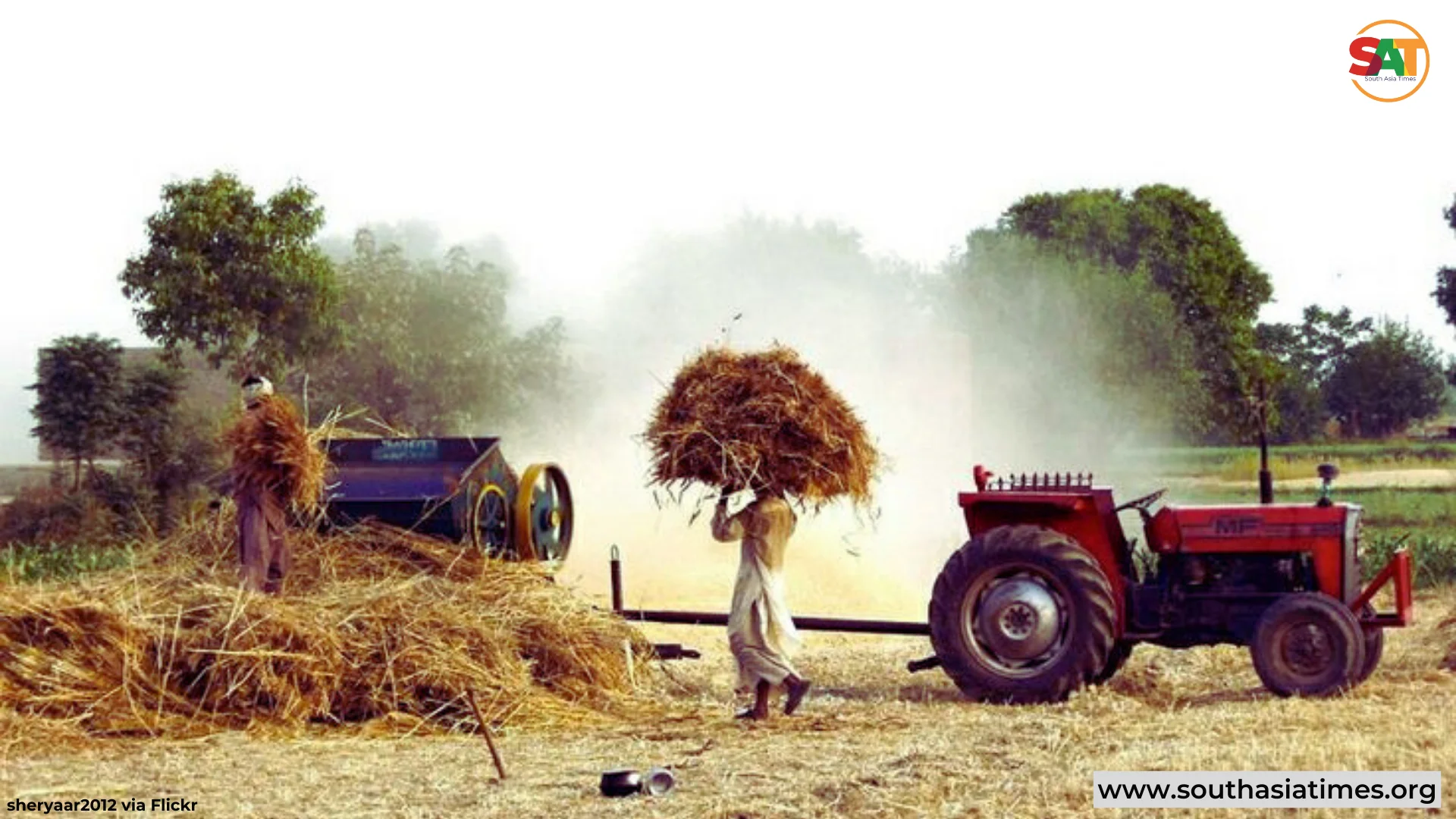Pakistan’s ongoing wheat crisis is not merely a matter of inconvenience; it’s a stark indicator of systemic failures that demand immediate attention and decisive action from the government. The repercussions of this crisis are reverberating throughout the nation, affecting not only farmers but also the broader population reliant on wheat-based staples like roti and naan.
Wheat Crisis: The Roots are Multifaceted!
Pakistan’s wheat crisis stems from a toxic mix of devastating floods, questionable policy decisions, and disruptions in global supply chains.
Floods
Devastating floods in 2022 wreaked havoc on the country’s agricultural infrastructure, leading to significant crop losses.
According to reports, the floods caused losses exceeding $30 billion and damaged approximately four million acres of crops, severely impacting wheat production in key regions such as Punjab and Sindh, which together account for the majority of Pakistan’s wheat output; that is around 77% and 15% respectively as per estimates.
![Wheat stocks worth Rs4b damaged in 2022 floods triggering a wheat crisis [File: Stringer/Reuters]](https://southasiatimes.org/wp-content/uploads/2024/04/2022-08-31T170730Z_963421851_RC227W9H4A75_RTRMADP_3_PAKISTAN-WEATHER.webp)
Policy Decisions
Additionally, political decisions have further exacerbated the situation.
Allegedly, the former Chief Minister of Punjab, Hamza Shehbaz, decided in May 2022, in coordination with the federal government, to release wheat from government stocks at subsidized rates shortly after the new crop had arrived. This move reportedly resulted in a scarcity of the essential commodity within the Punjab province triggering the chain of events.
Moreover, Sindh Chief Minister Murad Ali Shah’s announcement of a high wheat support price, nearly doubling it from Rs2,200 per 40kg in 2021-22 to Rs4,000 in 2022-23, further escalated wheat rates in open markets, contributing to the food crisis in the country.
Resultantly, in September 2023, Pakistan began importing wheat due to a domestic crop that was insufficient to meet demand. Moreover, Pakistan produced 27 million metric tons of wheat, compared to a consumption of 31 million metric tons.
The caretaker government, in February 2024 decided to ban state-level wheat imports to stabilize flour prices, citing abundant domestic reserves. The Economic Coordination Committee (ECC) made this decision due to stable flour prices and sufficient national reserves. This followed a briefing by the Ministry of National Food Security to the ECC, which commended proactive measures. Additionally, the ECC approved a Technical Supplementary Grant of 7.15 billion rupees for Federal Education and Professional Training.
Later, in March 2024, the opposition treasury lawmakers opposed the government’s wheat policy, labelling it the “farmer enemy policy” and alleging rampant corruption. Unionized farmers’ rallies were threatened in Punjab Province, denouncing low wheat support prices and highlighting the impending crisis.
![Farmers from Punjab Pakistan [dbimages / Alamy Stock Photo]](https://southasiatimes.org/wp-content/uploads/2024/04/addressing-pakistan-s-dreadful-agriculture-productivity-1687414186-3905-1024x800.webp)
Notably, Punjab’s farming community got ready for a province-wide protest against what they see as government indifference to the falling prices of wheat. Farmers in Punjab are at risk of being taken advantage of by private purchasers since the government has not yet stepped in to regulate the wheat market.
A section of Pakistan Kisan Ittehad (PKI) and the Kisan Board Pakistan (KBP) have announced their intention to intensify demonstrations. They mention how manipulation by stockists, intermediaries, and hoarders caused farmers to suffer significant losses.
Punjab’s farmers also conveyed their disappointment with Chief Minister Maryam Nawaz Sharif’s decision to maintain the previous year’s wheat support price. Furthermore, they cautioned to take legal action and stage protests if the government did not address their issue.
The governments of Sindh and Balochistan have fixed the support price at Rs 4,000 per 40 kg, whilst the governments of KPK and Punjab have set it at Rs 3,900 per 40 kg. This week, the matter also sparked contentious debates in the Punjab and National Assembly.
Food Minister Bilal Yasin explained in the Punjab Assembly that his department was unable to purchase the produce because it had a high moisture content (18%), which would cause the produce’s weight to decrease after drying and result in a loss for the government.
The Kisan Board Pakistan President Sardar Zafar said that “CM has maintained the last year’s support price of Rs3,900 per 40kg of wheat, while the Sindh province has enhanced it to Rs4,600 per 40kg.” He said that farmers should receive at least Rs 1,100 more per 40 kg of grain support price.
The Farmers’ turmoil compels Prime Minister Shehbaz to hike the wheat target. The official press release called the decision “a big relief” for farmers, adding that it was taken following complaints from wheat growers.
![The grain market in Sheikhupura [Murtaza Ali / White Star via Dawn]](https://southasiatimes.org/wp-content/uploads/2024/04/626b343b1ae9c.webp)
Russia Ukraine War
These factors have been compounded by disruptions in wheat supply chains due to global events like the Russia-Ukraine war.
Ukraine, the primary wheat supplier to Pakistan in the previous marketing year 2021-22, saw its exports to Pakistan disrupted by the conflict, making Russia the top exporter of wheat to the country. As a result, wheat imports from Russia, soared more than eightfold during the first eight months of the 2022–23 marketing year. Consequently, Pakistan, the world’s fifth-most populous country, became the fifth-largest importer of Russian wheat.
Despite efforts by the Pakistani government to secure wheat imports from Russia, the nation continued to face a significant deficit in wheat production, exacerbating its worst-ever flour crisis.
Wheat Woes and Pakistan’s Response
While the initiatives, such as increasing wheat procurement targets and directing swift purchasing, have been the steps in the right direction, they must be accompanied by data-driven comprehensive reforms addressing the underlying issues.
According to statistics, Pakistan faced a net wheat deficit of 2.37 million metric tons in the marketing year of 2023, with domestic production falling short of meeting the country’s growing consumption demands. This deficit underscores the urgent need for reforms to bolster domestic production capabilities and ensure food security for all citizens.
One critical area of concern is the inefficiencies within the wheat procurement process, plagued by embezzlement, lack of transparency, and exploitation of small-scale farmers by middlemen.
Reportedly, wheat producers often sell their crops for inadequate prices in the market, while ordinary citizens end up buying expensive flour, highlighting the need for reforms to address these systemic issues and ensure fair prices for both farmers and consumers.
Farmer Grievances
As far as the farmers’ protest is concerned, one of the key grievances fueling the farmer protests is the interplay between imported wheat and the minimum support price (MSP). Farmers argue that the government’s reliance on imported wheat, often at lower prices, depresses the market value of domestic wheat. This leaves them with lower profits, especially considering rising production costs. Additionally, if the MSP, meant to be a safety net, is set too low, it fails to incentivize them to sell to the government.
![Farmers' suspect exploitation and corruption in the wheat procurement system [Stock Images].](https://southasiatimes.org/wp-content/uploads/2024/04/63b232439051f-1.webp)
Farmers suspect corruption may also play a role, with middlemen potentially exploiting the system and buying wheat at lower prices to resell at the higher MSP. These factors combined have pushed farmers to take to the streets, demanding a fairer MSP, a more efficient procurement system, and a decrease in reliance on imported wheat.
Furthermore, the government’s response to farmer protests must prioritize dialogue and genuine efforts to address their grievances. Arrests and crackdowns only serve to escalate tensions and undermine trust in the authorities. Farmers are not adversaries but vital stakeholders whose livelihoods are intricately linked to the nation’s food security.
Transparency and accountability must be upheld at every level of governance, from procurement to distribution, to ensure that wheat reaches those in need at fair prices. Investment in agricultural infrastructure, modernization of procurement systems, and support for smallholder farmers are imperative for long-term sustainability.
Moreover, the government must resist short-sighted policies influenced by external pressures, such as subsidy withdrawals dictated by international financial institutions. The welfare of the Pakistani people, particularly the most vulnerable, must remain paramount in all decision-making processes.
As protests escalate and the wheat crisis deepens, the government faces a critical test of leadership and responsiveness. It’s time to move beyond temporary fixes and address the systemic issues plaguing Pakistan’s agricultural sector. Failure to do so risks not only exacerbating food insecurity but also eroding public trust in governance institutions. Swift, decisive action is needed to steer the nation toward a path of stability, resilience, and prosperity.
A Way Forward
Pakistan’s wheat crisis is a wake-up call, exposing vulnerabilities in its food security system. Floods, policy missteps, and global events combined to create a perfect storm. The path forward requires a data-driven, multi-pronged approach that empowers provinces and prioritizes long-term solutions.
1. Data-Driven Decision Making:
- Conduct regular, state-specific wheat need assessments using data analytics. This will provide a clear picture of provincial requirements, enabling targeted procurement and distribution efforts.
- Utilize data to streamline buffer stock management. By understanding regional consumption patterns, the government can optimize wheat reserves, ensuring timely availability across Pakistan.
2. Empowering Provinces:
- Strengthen provincial capabilities for wheat procurement and distribution, considering the post-18th amendment power dynamics. This can involve training programs and improved infrastructure for storage and transportation.
- Establish a data-sharing framework between federal and provincial governments. This will ensure transparency and facilitate informed decision-making at all levels.
3. Supporting Farmers:
- Launch a targeted subsidy program with a “Farmer Helpline” for registration and support. This program should be informed by data on fertilizer and seed needs in different regions.
- Provide subsidies for high-yielding wheat varieties and water-saving irrigation systems. Data analysis can help identify the most suitable technologies for specific regions, maximizing impact.
4. Transparency and Efficiency:
- Publish import and distribution details, including quantities, prices, and destinations, to combat corruption.
- Digitize markets for real-time price tracking and data-driven planning. This will improve market efficiency and benefit both farmers and consumers.
5. Fair Procurement and Farmer Input:
- Procure wheat directly from farmers at fair prices established through transparent negotiations with farmer unions. Data on production costs can guide minimum support price setting.
- Establish district-level committees for open communication between farmers and the government. This will allow for addressing grievances and creating a collaborative approach.
6. Long-Term Solutions:
- Invest in research and development for higher crop yields, improved disease resistance, and sustainable farming practices.
- Materialization of initiatives and long-term policies in the context of the Green Pakistan Initiative with the Special Investment Facilitation Council (SIFC) of Pakistan in the lead role may be considered.
- Strengthen market regulations to prevent exploitation by middlemen. Utilize data to track market trends and identify potential manipulation attempts.
- Explore direct subsidy transfers to farmers’ accounts. This can improve transparency and ensure subsidies reach their intended beneficiaries.
By adopting a data-driven approach, empowering provinces, and prioritizing long-term solutions, Pakistan can not only overcome the current crisis but also build a more resilient and sustainable wheat sector for the future. This will ensure food security for its citizens and prevent similar vulnerabilities from derailing progress in the long run.
Your go-to editorial hub for policy perspectives and informed analysis on pressing regional and global issues.



![18th Lok Sabha Elections in India: Voters line up to cast their ballots during phase one of Assam's state election in Koliabor [Dibyangshu Sarkar/AFP].](https://southasiatimes.org/wp-content/uploads/2024/04/000_96V298-150x150.webp)
![AJK unrest erupts as grievances over resource management and government transparency simmer. Will Pakistan address these concerns? [Image: WAPDA]](https://southasiatimes.org/wp-content/uploads/2024/05/SAT-Web-Banners-15-150x150.webp)
Add a Comment